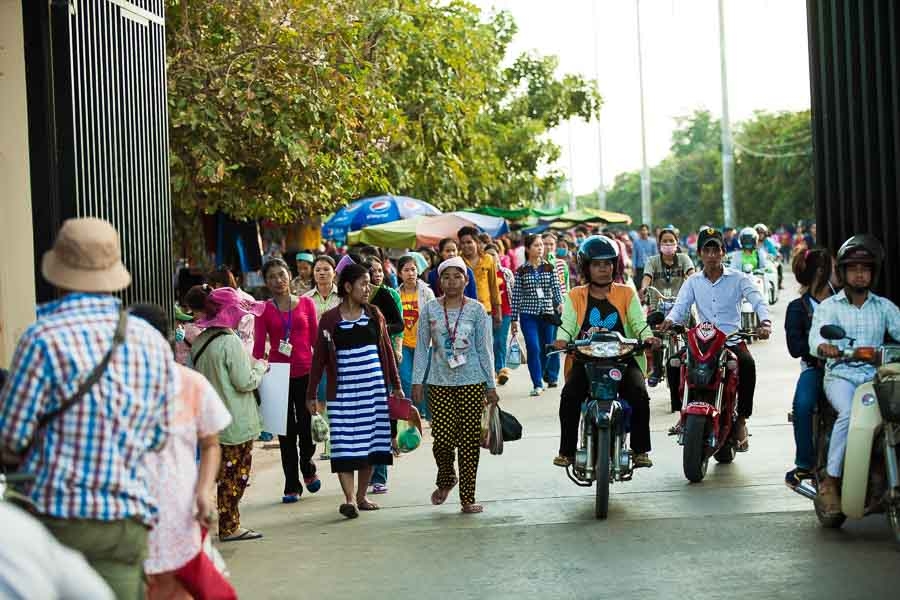Garment Sector Improvements Recommended
By
B2B Cambodia
on
 The AMRO report recommends fiscal policy which is more supportive of infrastructure investment and structural reforms. KHMER TIMES/Fabien Mouret
The Asean Macroeconomic Research Office has released a report advising the government and main garment association on how to improve the economic outlook of the country’s largest industry.
Following an annual visit to Cambodia from June 21 to 28, AMRO released a report on July 3 outlining what it thinks must be done to ensure further growth in the country’s garment sector. “Improving public sector capacities and rebalancing budget allocations toward more capital investments are crucial to enhance growth prospects,” the report said. “In the face of rising labour costs and relatively large infrastructure gaps, fiscal policy needs to be more supportive of much-needed infrastructure investment and structural reforms to enhance productivity and support growth.”
The report also emphasised enhancing labour quality, improving trade facilitation and reducing logistics and electricity costs as key to ensure the industry’s sustainability as it continues to show signs of diversification. Kaing Monina, deputy secretary general with the Garment Manufacturers Association of Cambodia, said he agreed with the points made in the AMRO report.
Monina said labour costs are of vital importance to GMAC, as they already hover at about $200 per month for the average garment worker. With a $153 minimum wage and mandatory allowance of $17 or more, the minimum salary is $170 already, he said. Adding up all incentives, bonuses and overtime work, workers are making about $200 or more.
“The public looking from outside say our wages are still low compared to other countries, but it's not true,” he said. “If we take into account the level of productivity and the less number of working days in Cambodia, our wages are about the same.”
In terms of logistics, according to Monina trucking costs are quite reasonable, but documentation charges and other service charges are very high. Long and complicated processes in some ministries also translate into financial losses for companies, he said.
The garment industry is one of four main pillars which support the country’s economic growth. Garment exports account for over 70% of Cambodia's total exports. AMRO has projected Cambodia’s economy to grow strongly at 6.9% in 2017 with inflation reaching about 4%.
This article was originally published in the Khmer Times.
The AMRO report recommends fiscal policy which is more supportive of infrastructure investment and structural reforms. KHMER TIMES/Fabien Mouret
The Asean Macroeconomic Research Office has released a report advising the government and main garment association on how to improve the economic outlook of the country’s largest industry.
Following an annual visit to Cambodia from June 21 to 28, AMRO released a report on July 3 outlining what it thinks must be done to ensure further growth in the country’s garment sector. “Improving public sector capacities and rebalancing budget allocations toward more capital investments are crucial to enhance growth prospects,” the report said. “In the face of rising labour costs and relatively large infrastructure gaps, fiscal policy needs to be more supportive of much-needed infrastructure investment and structural reforms to enhance productivity and support growth.”
The report also emphasised enhancing labour quality, improving trade facilitation and reducing logistics and electricity costs as key to ensure the industry’s sustainability as it continues to show signs of diversification. Kaing Monina, deputy secretary general with the Garment Manufacturers Association of Cambodia, said he agreed with the points made in the AMRO report.
Monina said labour costs are of vital importance to GMAC, as they already hover at about $200 per month for the average garment worker. With a $153 minimum wage and mandatory allowance of $17 or more, the minimum salary is $170 already, he said. Adding up all incentives, bonuses and overtime work, workers are making about $200 or more.
“The public looking from outside say our wages are still low compared to other countries, but it's not true,” he said. “If we take into account the level of productivity and the less number of working days in Cambodia, our wages are about the same.”
In terms of logistics, according to Monina trucking costs are quite reasonable, but documentation charges and other service charges are very high. Long and complicated processes in some ministries also translate into financial losses for companies, he said.
The garment industry is one of four main pillars which support the country’s economic growth. Garment exports account for over 70% of Cambodia's total exports. AMRO has projected Cambodia’s economy to grow strongly at 6.9% in 2017 with inflation reaching about 4%.
This article was originally published in the Khmer Times.